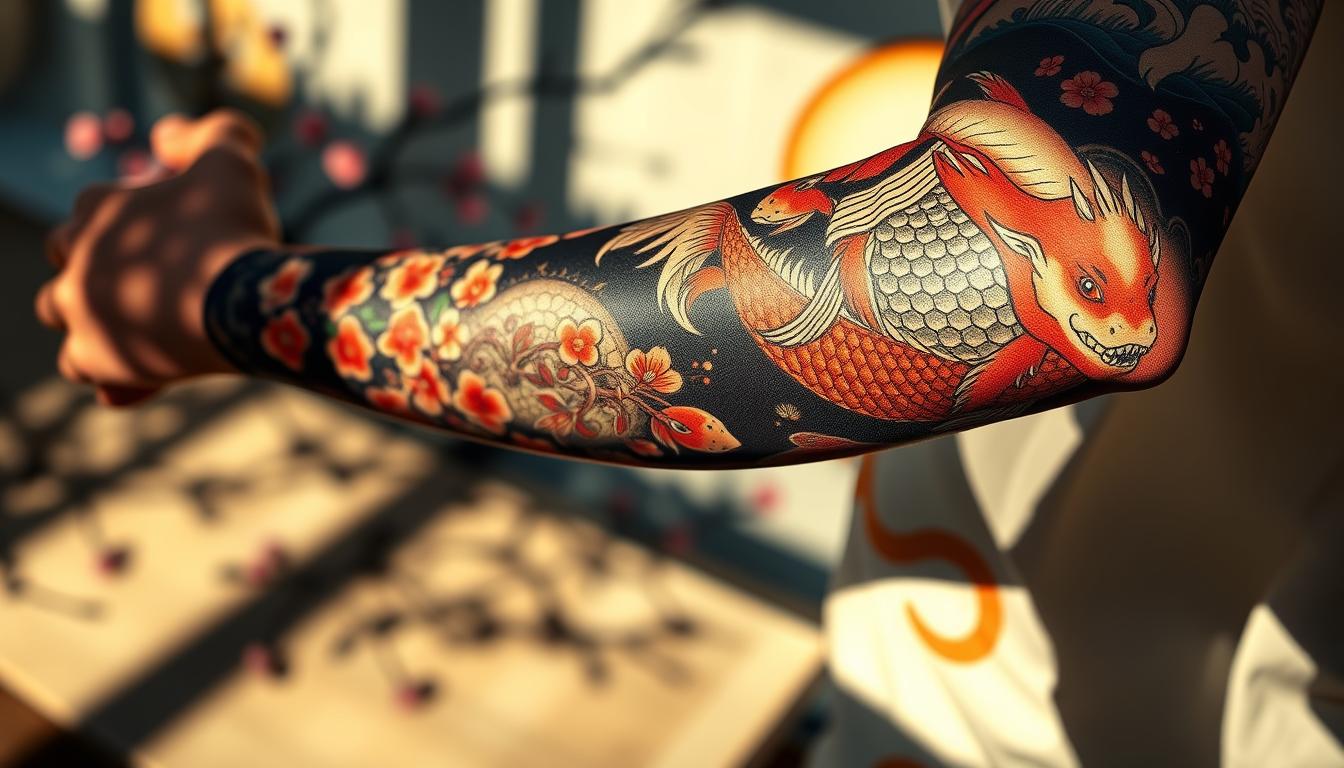
Traditional Japanese tattoo sleeves are renowned for their vivid colors and intricate patterns, telling unique stories that have captivated tattoo enthusiasts for centuries. With a history tracing back over 10,000 years, these wearable masterpieces hold a special place in the world of body art.
The art form represents more than just aesthetic appeal; it’s deeply rooted in cultural symbolism and historical significance. Elements like dragons, koi fish, and cherry blossoms are not just visually striking but also carry profound meanings.
Understanding the symbolism behind these designs can enhance appreciation for their artistic value and cultural importance.
Key Takeaways
- Discover the ancient origins and modern significance of Japanese tattoo sleeves.
- Learn about the symbolic expressions and cultural meanings behind the designs.
- Explore the evolution of Japanese tattoo art and its global recognition.
- Understand the importance of finding the right artist for your tattoo.
- Gain insights into planning your own Japanese sleeve tattoo.
The Rich History of Japanese Tattoo Art
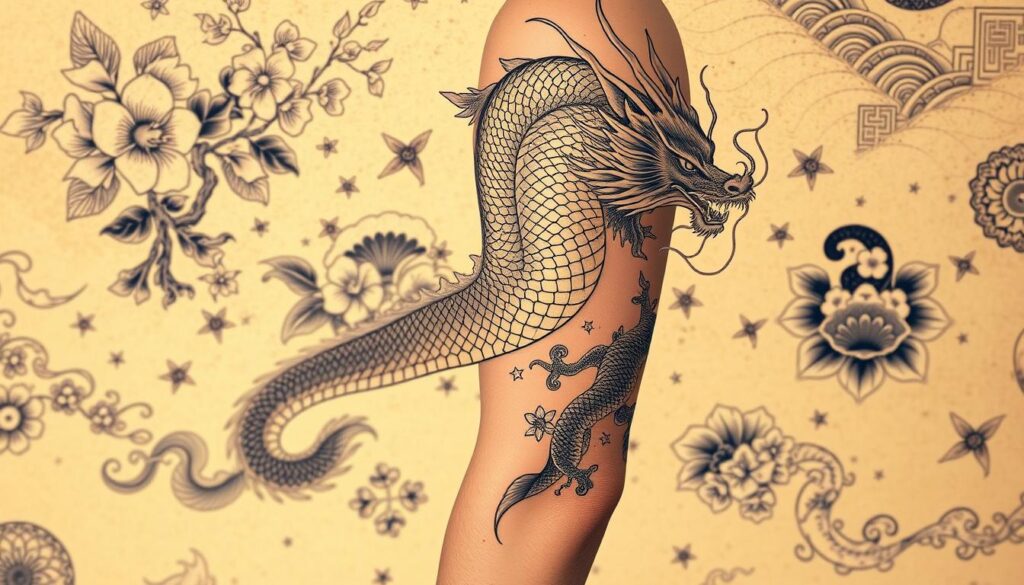
With a history that stretches back over 10,000 years, Japanese tattoo art is one of the oldest in the world. Evidence of early prehistoric tattooing can be traced back to this time in Japan.
Ancient Origins Dating Back 10,000 Years
Initially, tattoos were worn by the lower classes, including criminals and artisans. The practice served both decorative and spiritual purposes, with designs evolving from simple markings to elaborate artistic expressions. Archaeological evidence supports that Japanese tattoos have one of the oldest and richest histories in the world, dating back 10,000 years.
From Taboo to Global Phenomenon
Over the years, the Yakuza, Japan’s notorious organized crime syndicate, popularized tattoos, decorating their bodies with traditional Japanese designs such as koi fish and dragons. Despite being taboo in Japanese society for centuries, these tattoos gained international recognition for their artistic merit and symbolic depth. For more information on Japanese tattoos, explore the cultural significance and history.
Today, Japanese tattoo art has transcended its controversial past to become one of the most respected and influential styles in the global tattoo community, appreciated by people worldwide.
Understanding the Japanese Tattoo Sleeve
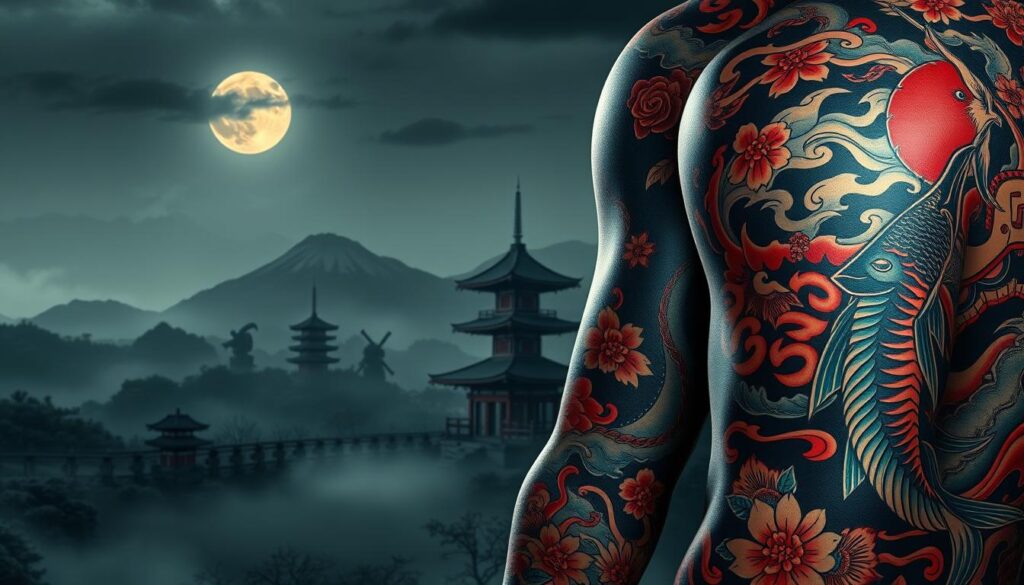
Delving into the world of Japanese tattoo sleeves reveals a complex interplay of tradition, art, and cultural significance. The intricate designs and symbols used in traditional Japanese tattoo sleeves reflect the culture, beliefs, and values of the Japanese people.
What Makes Japanese Sleeves Unique
Japanese tattoo sleeves are distinguished by their cohesive narrative quality, where all elements flow together to tell a complete story across the entire arm. Unlike other tattoo styles, traditional Japanese sleeves incorporate background elements like waves, clouds, or wind bars to connect the main motifs. The composition follows specific rules regarding placement, with certain images belonging on particular parts of the body according to tradition.
| Characteristics | Description |
|---|---|
| Cohesive Narrative | Elements flow together to tell a complete story |
| Background Elements | Waves, clouds, or wind bars connect main motifs |
| Traditional Placement | Specific images belong on particular body parts |
The Cultural Significance in Modern Times
The cultural significance of Japanese tattoo sleeves has evolved significantly over time. Once associated with criminal activity, these tattoos are now celebrated and appreciated worldwide for their artistic and symbolic value. Many wearers are drawn to both the visual impact and the deep symbolic meanings behind the traditional imagery, such as dragons and koi fish, which represent strength, courage, and good fortune.
In modern times, traditional Japanese tattoos continue to gain respect internationally, with many artists incorporating contemporary techniques while maintaining traditional aesthetics. This blend of old and new has contributed to the global appreciation of Japanese sleeve tattoos.
Powerful Symbols in Japanese Tattoo Sleeves
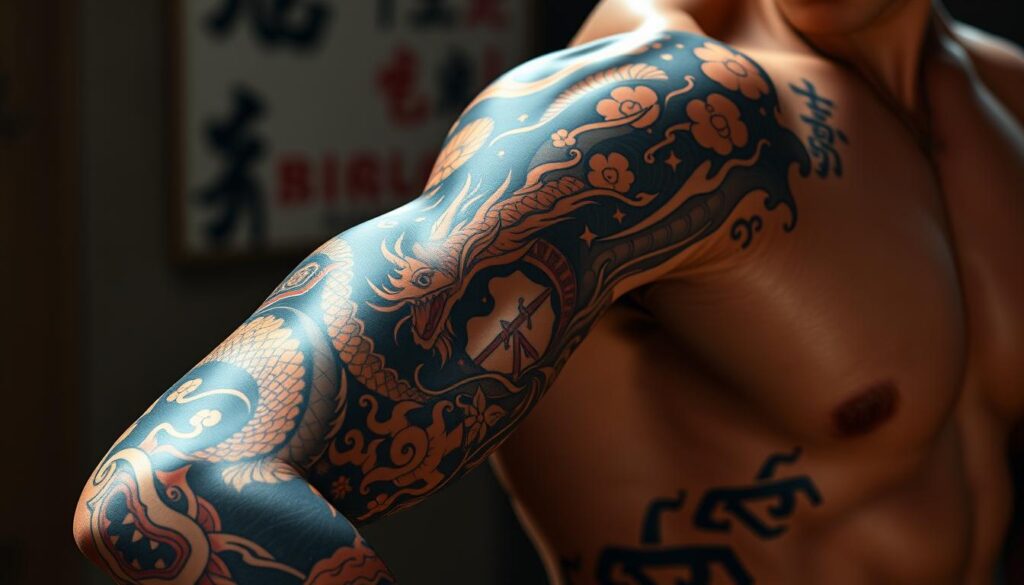
Symbolism plays a crucial role in Japanese tattoo art, with various motifs representing different aspects of life and Japanese mythology. These symbols are often combined in intricate designs to convey meaningful narratives.
In traditional Japanese tattooing, certain symbols stand out for their significance and beauty. Among these, dragons, koi fish, and cherry blossoms are particularly revered.
Dragons: Strength and Divine Protection
Dragons, or “Ryū,” are considered divine creatures in Japanese mythology, embodying wisdom, strength, and supernatural powers. They are often depicted controlling the elements, such as water and wind, and are believed to offer protection.
- Unlike their Western counterparts, Japanese dragons are typically benevolent, with serpentine bodies and sharp claws.
- Their depiction in tattoo art showcases the artist’s skill through elaborate details.
Koi Fish: Perseverance and Transformation
The koi fish is another powerful symbol, representing perseverance and determination. According to legend, koi swimming upstream against powerful currents can transform into dragons upon reaching the “dragon’s gate.”
- Koi fish tattoos often feature the fish navigating turbulent waters, symbolizing the wearer’s ability to overcome obstacles.
- This motif is rooted in the legend of koi swimming up the Yellow River to become dragons.
Cherry Blossoms: Beauty and Impermanence
Cherry blossoms, or “sakura,” embody the Japanese concept of “mono no aware,” or the appreciation of beauty’s impermanence. These flowers bloom spectacularly but briefly each spring.
- In tattoo art, cherry blossoms represent the fleeting nature of life, reminding us to cherish every moment.
- The delicate petals of cherry blossoms showcase the technical mastery required in Japanese tattoo art.
These symbols are frequently combined in sleeve designs to create narratives about transformation, strength, and the ephemeral nature of existence. The positioning of these elements is crucial in traditional Japanese tattoo composition.
Traditional Japanese Tattoo Techniques
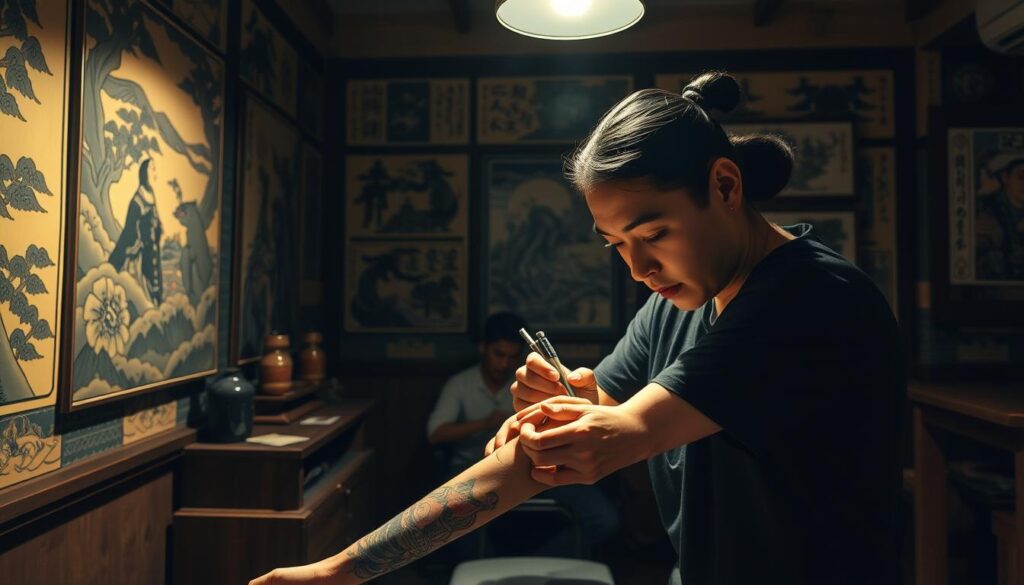
Traditional Japanese tattoo techniques have been passed down through generations, preserving the cultural heritage of Japan. These techniques are not just about creating art on the skin but are deeply rooted in the history and spirituality of Japanese culture.
The Art of Tebori
Tebori, meaning “hand-carved,” is the traditional Japanese hand-poked tattooing method that has been revered for its distinctive quality. This ancient technique involves using a metal-tipped wooden or bamboo stick, known as a nomi, to manually insert ink into the skin, creating a depth and texture that machine tattoos cannot replicate. The process is not just about the physical act of tattooing but is considered a meditative experience, with the rhythmic sound of the needles entering the skin being a significant part of the ritual.
The traditional tebori method requires immense skill and patience, with masters undergoing rigorous apprenticeships lasting 5-10 years. This extensive training is not just about mastering the technique but also about understanding the cultural and spiritual aspects of Japanese tattooing. The result is a tattoo that is both beautiful and meaningful, with a unique visual quality that is highly prized.
Modern Adaptations
While traditional tebori remains highly respected, modern Japanese tattoo artists have begun to blend traditional techniques with contemporary tools. Some artists use electric tattoo machines for outlining and tebori for shading, achieving a balance between traditional authenticity and modern precision. This blend of old and new has led to a new generation of artists committed to preserving traditional methods while making them relevant for today’s tattoo clients.
| Technique | Description | Characteristics |
|---|---|---|
| Tebori | Hand-poked method using a metal-tipped stick | Unique texture, depth, and cultural authenticity |
| Modern Adaptation | Blends traditional tebori with electric machines | Balances traditional quality with modern precision |
The art of traditional Japanese tattooing continues to evolve, with artists finding new ways to preserve the traditional techniques while catering to modern tastes. The result is a vibrant and dynamic art form that continues to captivate audiences around the world.
Popular Japanese Tattoo Sleeve Designs
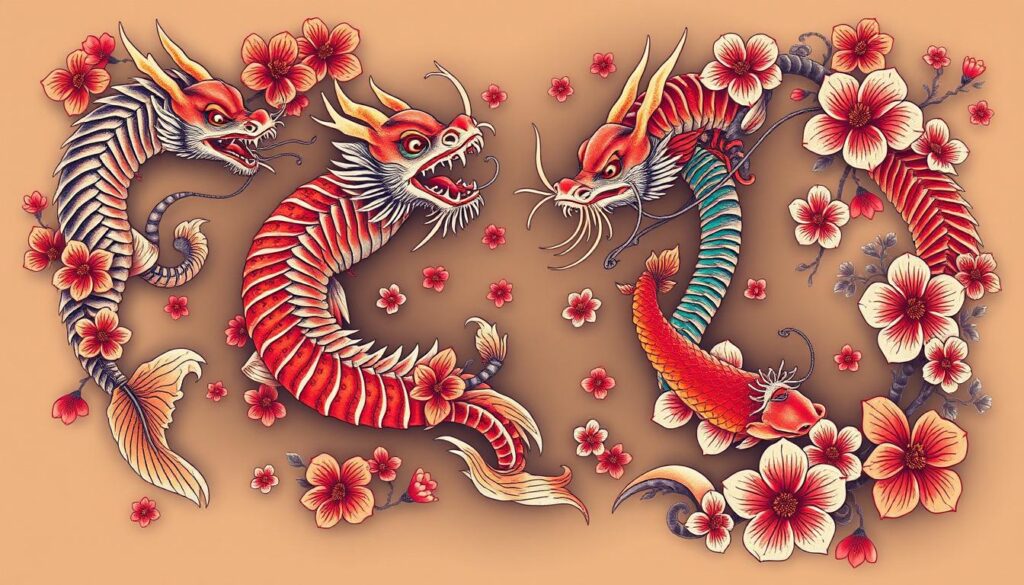
Japanese tattoo sleeve designs have become increasingly popular worldwide, captivating art enthusiasts with their intricate patterns and symbolic meanings. These designs are not only aesthetically pleasing but also carry deep cultural significance.
Full Sleeve vs. Half Sleeve Options
When it comes to Japanese tattoo sleeves, individuals can choose between full and half sleeve options. Full Japanese sleeve tattoos extend from the shoulder to the wrist, creating a comprehensive canvas for elaborate narratives. In contrast, half sleeves stop at the elbow, offering a more subtle option that’s easier to conceal.
Water and Wave Designs
Water and wave designs are crucial background elements in Japanese sleeve tattoos, connecting other motifs while symbolizing life’s constant change and the power of nature. The distinctive blue waves found in Japanese tattoos are often inspired by Hokusai’s famous “Great Wave off Kanagawa” woodblock print.
Mythological Creatures and Deities
Mythological creatures beyond dragons and koi include the phoenix, representing rebirth and triumph, and the tiger, symbolizing courage and strength. Japanese deities and folklore characters, such as Fudo Myoo and Kannon, frequently appear in sleeve designs, adding layers of meaning and cultural significance.
Other popular motifs include Oni (demons), representing the struggle between good and evil, and various floral elements like peonies and chrysanthemums, which symbolize wealth, good fortune, and longevity. Traditional Japanese sleeve designs follow specific rules about which elements can be paired together and how they should be positioned on the body.
Finding the Right Tattoo Artist
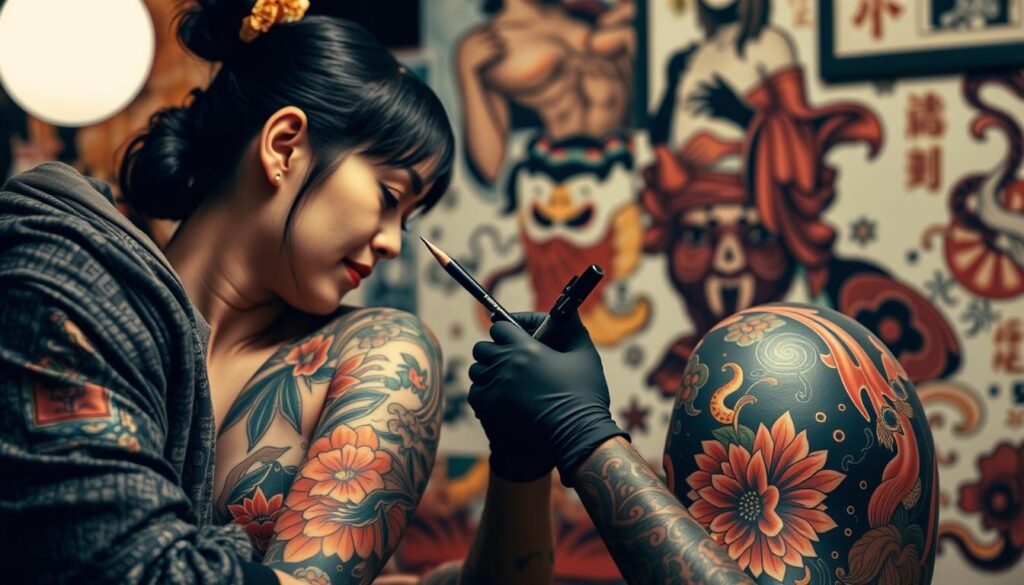
To get an authentic Japanese tattoo, you need to locate a talented tattoo artist who understands the traditional techniques and symbolism. If you’re searching for “Japanese tattoo artists near me,” you’ll find numerous skilled professionals who can help you achieve your desired sleeve.
What to Look for in a Japanese Tattoo Specialist
When selecting a tattoo artist for your Japanese sleeve tattoo, look for someone with a dedicated portfolio showcasing their understanding of traditional elements and ability to create cohesive designs. A legitimate Japanese tattoo specialist should be able to explain the meaning behind traditional symbols and help you choose elements that create a meaningful narrative for your sleeve.
Questions to Ask Before Your Appointment
Before committing to a tattoo artist, ask about their training background, experience with traditional Japanese designs, and their approach to customization. Discuss the time commitment required for your sleeve, as traditional Japanese tattoos typically need multiple sessions over several months or years. Inquire about their process for creating sleeve designs and ask for references from previous clients to ensure you’re in good hands.
Planning Your Japanese Tattoo Sleeve

A Japanese tattoo sleeve is a substantial investment in body art that demands thoughtful planning. Traditional Japanese tattoo designs are rich in symbolism, and understanding their meanings is crucial to making an informed decision.
Design Considerations and Placement
When planning your Japanese tattoo sleeve, it’s essential to consider both aesthetic elements and practical factors. The placement of your tattoo is just as important as the design itself, as it should complement your body type and meet any dress code requirements.
- Traditional Japanese sleeves follow specific compositional rules, with larger motifs typically placed on the upper arm or shoulder.
- Consider your body’s natural contours when planning your sleeve to ensure a harmonious design.
- Background elements like water and clouds are essential components that create cohesion and flow throughout the piece.
Understanding the Time and Cost Investment
Getting a Japanese tattoo sleeve is a significant time and financial investment. A full sleeve typically requires 40-60 hours of tattooing spread across multiple sessions.
- Be prepared for a significant time investment, as sessions are spread over months or even years.
- The cost of a quality Japanese sleeve from a specialized artist typically ranges from $5,000 to $10,000 or more.
- Discuss healing time between sessions with your artist to ensure proper healing and color retention.
Conclusion: Embracing the Art of Japanese Tattoo Sleeves
Embracing a Japanese tattoo sleeve is not just about getting a tattoo; it’s about becoming part of a centuries-old cultural tradition. With their rich symbolism and beautiful tattoo designs, Japanese sleeves have become a popular choice for those seeking meaningful body art. As you’ve explored, this ancient art form offers more than just aesthetic appeal; it connects you with a legacy that spans thousands of years. For more inspiration on other tattoo styles, you can explore back tattoos for men. Ultimately, a Japanese tattoo sleeve is a timeless piece that reflects your unique personality and story.
